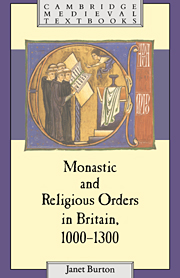Book contents
- Frontmatter
- Contents
- List of illustrations
- Preface
- 1 Before the Normans
- 2 The coming of the Normans
- 3 The regular canons
- 4 The new monastic orders of the twelfth century
- 5 Women and the religious life
- 6 The mendicant orders
- 7 The physical setting: monastic buildings and the monastic plan
- 8 Inside a religious house: daily life and the chain of command
- 9 Learning and literary activities
- 10 Religious houses and the wider community: founders, patrons and benefactors
- 11 The monastic economy
- 12 On the brink of change
- Glossary
- Notes
- Select bibliography
- Index
- Cambridge Medieval Textbooks
1 - Before the Normans
Published online by Cambridge University Press: 05 June 2012
- Frontmatter
- Contents
- List of illustrations
- Preface
- 1 Before the Normans
- 2 The coming of the Normans
- 3 The regular canons
- 4 The new monastic orders of the twelfth century
- 5 Women and the religious life
- 6 The mendicant orders
- 7 The physical setting: monastic buildings and the monastic plan
- 8 Inside a religious house: daily life and the chain of command
- 9 Learning and literary activities
- 10 Religious houses and the wider community: founders, patrons and benefactors
- 11 The monastic economy
- 12 On the brink of change
- Glossary
- Notes
- Select bibliography
- Index
- Cambridge Medieval Textbooks
Summary
THE BACKGROUND: TWO ‘GOLDEN AGES’
Monasticism reached Anglo-Saxon England with the mission sent by Pope Gregory the Great from Rome in 597 to begin the conversion of the Anglo-Saxons. Its leader was a monk, Augustine, and the base which he established for his activities was a monastery dedicated to St Peter and St Paul (later St Augustine's) in Canterbury. Thus monasticism was an important and integral part of Christianity from its earliest days in England, and as Augustine's mission advanced further into the Anglo- Saxon kingdoms, other monasteries were sponsored by kings and queens who embraced the new religion. The daily routine at the Canterbury house and at others which the conversion spawned would have been that with which Augustine was familiar from the religious houses of Rome; and among the monastic observances of the time the Rule of Benedict of Nursia (c. 480–550), written for the monastery of Monte Cassino, probably after 535, was beginning to gain currency. But although it is likely that Benedict's Rule was used in the Roman monasteries and in others influenced by them, it was only one of several available, and it was some time before it emerged as the basis of monastic observance throughout the West. It is more appropriate, therefore, to think of religious houses in early Anglo-Saxon England following a pattern of existence shaped both by Benedict's rule and by local customs.
- Type
- Chapter
- Information
- Monastic and Religious Orders in Britain, 1000–1300 , pp. 1 - 20Publisher: Cambridge University PressPrint publication year: 1994

